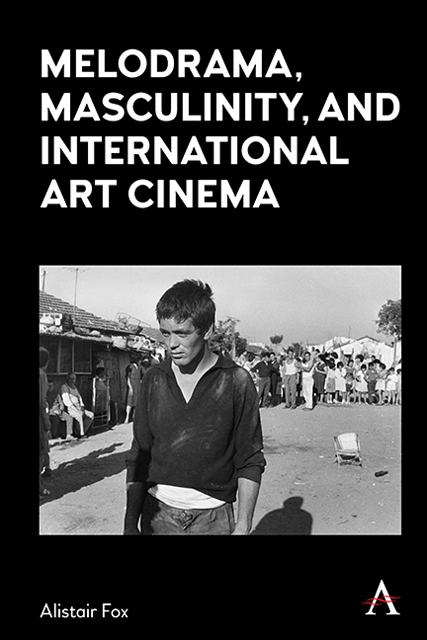Book contents
- Frontmatter
- Dedication
- Contents
- List of Figures
- Preface
- Acknowledgments
- Introduction
- Chapter 1 Italian Neorealism and the Emergence of the Male Melodrama: Vittorio De Sica’s Bicycle Thieves (1948) and Umberto D. (1952)
- Chapter 2 The Migration of Male Melodrama into Non-Western Cultures: Satyajit Ray’s The Apu Trilogy (1955–59) and “Fourth Cinema”
- Chapter 3 Hollywood Melodrama as a Vehicle for Self-Projection: Vincente Minnelli’s Tea and Sympathy (1956) and Home from the Hill (1960)
- Chapter 4 The Political Turns Personal: Neo-Neorealism and Pier Paolo Pasolini’s Accattone (1961)
- Chapter 5 Personal Cinema as Psychodrama: Ingmar Bergman’s Wild Strawberries (1957), Winter Light (1963) and Hour of the Wolf (1968)
- Chapter 6 François Truffaut and the Tyranny of Romantic Obsession: The Soft Skin (1964), Mississippi Mermaid (1969) and The Woman Next Door (1981)
- Chapter 7 Figuring an Authorial Fantasmatic: Jacques Demy’s The Umbrellas of Cherbourg (1964), A Room In Town (1982) and Parking (1985)
- Chapter 8 Rainer Werner Fassbinder and the Emergence of Queer Cinema: The Merchant of Four Seasons (1972), Fox and His Friends (1975) and In a Year with 13 Moons (1978)
- Chapter 9 Visual Aestheticism and the Queer Prestige Melodrama: Call Me by Your Name (2017) and Luca Guadagnino’s Desire Trilogy
- Conclusion
- List of Films Cited
- Select Bibliography
- Index
Chapter 2 - The Migration of Male Melodrama into Non-Western Cultures: Satyajit Ray’s The Apu Trilogy (1955–59) and “Fourth Cinema”
Published online by Cambridge University Press: 10 January 2023
- Frontmatter
- Dedication
- Contents
- List of Figures
- Preface
- Acknowledgments
- Introduction
- Chapter 1 Italian Neorealism and the Emergence of the Male Melodrama: Vittorio De Sica’s Bicycle Thieves (1948) and Umberto D. (1952)
- Chapter 2 The Migration of Male Melodrama into Non-Western Cultures: Satyajit Ray’s The Apu Trilogy (1955–59) and “Fourth Cinema”
- Chapter 3 Hollywood Melodrama as a Vehicle for Self-Projection: Vincente Minnelli’s Tea and Sympathy (1956) and Home from the Hill (1960)
- Chapter 4 The Political Turns Personal: Neo-Neorealism and Pier Paolo Pasolini’s Accattone (1961)
- Chapter 5 Personal Cinema as Psychodrama: Ingmar Bergman’s Wild Strawberries (1957), Winter Light (1963) and Hour of the Wolf (1968)
- Chapter 6 François Truffaut and the Tyranny of Romantic Obsession: The Soft Skin (1964), Mississippi Mermaid (1969) and The Woman Next Door (1981)
- Chapter 7 Figuring an Authorial Fantasmatic: Jacques Demy’s The Umbrellas of Cherbourg (1964), A Room In Town (1982) and Parking (1985)
- Chapter 8 Rainer Werner Fassbinder and the Emergence of Queer Cinema: The Merchant of Four Seasons (1972), Fox and His Friends (1975) and In a Year with 13 Moons (1978)
- Chapter 9 Visual Aestheticism and the Queer Prestige Melodrama: Call Me by Your Name (2017) and Luca Guadagnino’s Desire Trilogy
- Conclusion
- List of Films Cited
- Select Bibliography
- Index
Summary
By foregrounding the experience of those who were socially and economically disadvantaged, the Italian neorealists opened the way for other filmmakers in marginalized groups to exploit cinema’s potential for representing the experience of their own cultures on screen. One of the great masters of cinema, the Bengali filmmaker Satyajit Ray, has revealed that he was inspired to make his first film, Pather Panchali (1955), as a result of seeing Vittorio De Sica’s Bicycle Thieves in 1950, while he was staying in London. Pather Panchali, which was instantly recognized as a masterpiece, receiving many awards from film festivals around the world, was soon extended into a trilogy with the addition of Aparajito (1956) and The World of Apu (Apur Sansar, 1959), all of which traced the developing experience and turbulent emotional life of its central character, Apu, as he seeks to come to terms with the personal conflicts facing a young man who has to confront the prospect of separating himself from his family and their traditional way of life. To do so means leaving his rural, impoverished village in order to embrace the expansive possibilities of a new, emerging world, following the independence of India after more than a century’s colonial rule.
Later, filmmakers in other countries would follow in Ray’s footsteps. To take but one example, in New Zealand, the pioneering Māori filmmaker Barry Barclay (1944–2008) developed a comprehensive theory of what he called a “Fourth Cinema.” In contradistinction to the preoccupations and conventions of First-World cinema, Barclay argued, this Fourth Cinema should aim to transmit the stories of indigenous people in their own image, drawing upon indigenous stories and cultural values, and using indigenous crews and actors. This theory found its perfect exemplification in Mauri (Merata Mita, 1988), which, through a representation of the psychic torments of a Māori man who has transgressed against the tapu of his own culture, showed that a woman could depict masculine interior experience just as profoundly as any male director could portray that of a woman.
Satyajit Ray’s Imitation of Italian Neorealism
When Satyajit Ray saw De Sica’s Bicycle Thieves, what appealed to him about the film was its “triumphant rediscovery of the fundamentals of cinema,” which, for Ray, consisted of “the simple universality of its theme, the effectiveness of its treatment, and the low cost of its production.”
- Type
- Chapter
- Information
- Melodrama, Masculinity and International Art Cinema , pp. 35 - 56Publisher: Anthem PressPrint publication year: 2022



